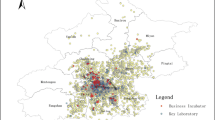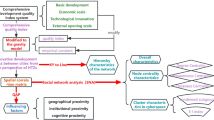Abstract
With the orientation of the capital’s four functions defined as political center, cultural center, international communication center, and innovative center of science and technology, the development of innovative ability of science and technology in Beijing has been upgraded to a national strategy. This chapter analyzes the spatial evolution of Beijing’s high-tech industry based on enterprise data and further explains how government policies influence the spatial evolution. Results show that spatial distribution of high-tech industries in Beijing spread from city center to the periphery gradually under the guidance of government policies, which demonstrates that top-down policies play a key role in the innovation-driven stage of city development. According to the concept mode of spatial evolution of Beijing’s high-tech industry, future strategy should focus on fostering multiple leading cores to guide the cooperation among all districts, further integrating them into a well-collaborative network, in order to improve the comprehensive ability in the innovation of science and technology.
Access this chapter
Tax calculation will be finalised at checkout
Purchases are for personal use only
Similar content being viewed by others
Notes
- 1.
- 2.
- 3.
- 4.
- 5.
- 6.
Surviving enterprises refer to enterprises that exist at the end of the year.
- 7.
Surviving registered capital refer to the total capital that surviving enterprises have at the end of the year.
- 8.
- 9.
- 10.
- 11.
- 12.
- 13.
- 14.
References
Chen, J. (2005). Empirical analysis on economic development promoted by science and technology (Master thesis). Beijing: Capital University of Economics and Business.
European Commission. (2010). Europe 2020: A strategy for smart, sustainable and inclusive growth: Communication from the commission. Publications Office of the European Union. http://ec.europa.eu/europe2020/index_en.htm
Li, M. (2015). Research on the influence of technological innovation about employment number and structure in Beijing (Doctoral dissertation). Beijing: Beijing Jiaotong University.
Li, G., & Lu, M. (2002). The preliminary research on the mode and policy tendency of Beijing being constructed into a World City. Scientia Geographica Sinica, 22(3), 263–269.
Porter, M. E. (1998). Clusters and the new economics of competition (vol. 76, no. 6, pp. 77–90). Boston: Harvard Business Review.
Sassen, S. (2001). The global city: New York, London, Tokyo. Princeton: Princeton University Press.
Sun, M. (2008). The grey comprehensive evaluation of Fujian province’s scientific & technological innovation capacity (Master thesis). Xiamen: Xiamen University.
Wang, W. (2007). Impact and strategies of scientific and technological innovation on economic development of capital (Master thesis). Beijing: Capital Normal University.
Yuan, X. (2014). Research on the planning of innovation-driven science and technology city (Doctoral dissertation). Beijing: Tsinghua University.
Zhang, Y. (2011). On Beijing effort for international tech-innovation hub and international urban strategy. China Open Journal, 5, 50–53.
Zhang, H. (2012). Comparison of S&T innovation function development of Beijing and Shanghai (Master thesis). Shanghai: East China Normal University.
Zhao, Z., Liu, Y., et al. (2015). Strategies and estimation system of Beijing constructing scientific and technological center. China Development Observation, 6, 77–81.
Author information
Authors and Affiliations
Corresponding author
Editor information
Editors and Affiliations
Rights and permissions
Copyright information
© 2018 Springer International Publishing AG
About this chapter
Cite this chapter
Li, J., Li, M., Dang, A., Song, Z. (2018). The Spatial and Temporal Evolution of Innovative Function of Science and Technology of Beijing Based on the Analysis of Enterprise Data. In: Shen, Z., Li, M. (eds) Big Data Support of Urban Planning and Management. Advances in Geographic Information Science. Springer, Cham. https://doi.org/10.1007/978-3-319-51929-6_11
Download citation
DOI: https://doi.org/10.1007/978-3-319-51929-6_11
Published:
Publisher Name: Springer, Cham
Print ISBN: 978-3-319-51928-9
Online ISBN: 978-3-319-51929-6
eBook Packages: Earth and Environmental ScienceEarth and Environmental Science (R0)




